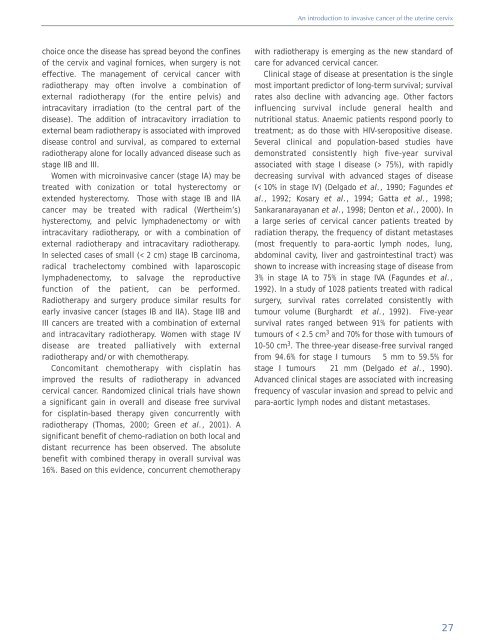Colposcopy and Treatment of Cervical Intraepithelial Neoplasia - RHO
Colposcopy and Treatment of Cervical Intraepithelial Neoplasia - RHO
Colposcopy and Treatment of Cervical Intraepithelial Neoplasia - RHO
Create successful ePaper yourself
Turn your PDF publications into a flip-book with our unique Google optimized e-Paper software.
An introduction to invasive cancer <strong>of</strong> the uterine cervix<br />
choice once the disease has spread beyond the confines<br />
<strong>of</strong> the cervix <strong>and</strong> vaginal fornices, when surgery is not<br />
effective. The management <strong>of</strong> cervical cancer with<br />
radiotherapy may <strong>of</strong>ten involve a combination <strong>of</strong><br />
external radiotherapy (for the entire pelvis) <strong>and</strong><br />
intracavitary irradiation (to the central part <strong>of</strong> the<br />
disease). The addition <strong>of</strong> intracavitory irradiation to<br />
external beam radiotherapy is associated with improved<br />
disease control <strong>and</strong> survival, as compared to external<br />
radiotherapy alone for locally advanced disease such as<br />
stage IIB <strong>and</strong> III.<br />
Women with microinvasive cancer (stage IA) may be<br />
treated with conization or total hysterectomy or<br />
extended hysterectomy. Those with stage IB <strong>and</strong> IIA<br />
cancer may be treated with radical (Wertheim’s)<br />
hysterectomy, <strong>and</strong> pelvic lymphadenectomy or with<br />
intracavitary radiotherapy, or with a combination <strong>of</strong><br />
external radiotherapy <strong>and</strong> intracavitary radiotherapy.<br />
In selected cases <strong>of</strong> small (< 2 cm) stage IB carcinoma,<br />
radical trachelectomy combined with laparoscopic<br />
lymphadenectomy, to salvage the reproductive<br />
function <strong>of</strong> the patient, can be performed.<br />
Radiotherapy <strong>and</strong> surgery produce similar results for<br />
early invasive cancer (stages IB <strong>and</strong> IIA). Stage IIB <strong>and</strong><br />
III cancers are treated with a combination <strong>of</strong> external<br />
<strong>and</strong> intracavitary radiotherapy. Women with stage IV<br />
disease are treated palliatively with external<br />
radiotherapy <strong>and</strong>/or with chemotherapy.<br />
Concomitant chemotherapy with cisplatin has<br />
improved the results <strong>of</strong> radiotherapy in advanced<br />
cervical cancer. R<strong>and</strong>omized clinical trials have shown<br />
a significant gain in overall <strong>and</strong> disease free survival<br />
for cisplatin-based therapy given concurrently with<br />
radiotherapy (Thomas, 2000; Green et al., 2001). A<br />
significant benefit <strong>of</strong> chemo-radiation on both local <strong>and</strong><br />
distant recurrence has been observed. The absolute<br />
benefit with combined therapy in overall survival was<br />
16%. Based on this evidence, concurrent chemotherapy<br />
with radiotherapy is emerging as the new st<strong>and</strong>ard <strong>of</strong><br />
care for advanced cervical cancer.<br />
Clinical stage <strong>of</strong> disease at presentation is the single<br />
most important predictor <strong>of</strong> long-term survival; survival<br />
rates also decline with advancing age. Other factors<br />
influencing survival include general health <strong>and</strong><br />
nutritional status. Anaemic patients respond poorly to<br />
treatment; as do those with HIV-seropositive disease.<br />
Several clinical <strong>and</strong> population-based studies have<br />
demonstrated consistently high five-year survival<br />
associated with stage I disease (> 75%), with rapidly<br />
decreasing survival with advanced stages <strong>of</strong> disease<br />
(< 10% in stage IV) (Delgado et al., 1990; Fagundes et<br />
al., 1992; Kosary et al., 1994; Gatta et al., 1998;<br />
Sankaranarayanan et al., 1998; Denton et al., 2000). In<br />
a large series <strong>of</strong> cervical cancer patients treated by<br />
radiation therapy, the frequency <strong>of</strong> distant metastases<br />
(most frequently to para-aortic lymph nodes, lung,<br />
abdominal cavity, liver <strong>and</strong> gastrointestinal tract) was<br />
shown to increase with increasing stage <strong>of</strong> disease from<br />
3% in stage IA to 75% in stage IVA (Fagundes et al.,<br />
1992). In a study <strong>of</strong> 1028 patients treated with radical<br />
surgery, survival rates correlated consistently with<br />
tumour volume (Burghardt et al., 1992). Five-year<br />
survival rates ranged between 91% for patients with<br />
tumours <strong>of</strong> < 2.5 cm 3 <strong>and</strong> 70% for those with tumours <strong>of</strong><br />
10-50 cm 3 . The three-year disease-free survival ranged<br />
from 94.6% for stage I tumours 5 mm to 59.5% for<br />
stage I tumours 21 mm (Delgado et al., 1990).<br />
Advanced clinical stages are associated with increasing<br />
frequency <strong>of</strong> vascular invasion <strong>and</strong> spread to pelvic <strong>and</strong><br />
para-aortic lymph nodes <strong>and</strong> distant metastases.<br />
27
















